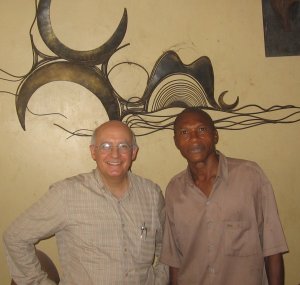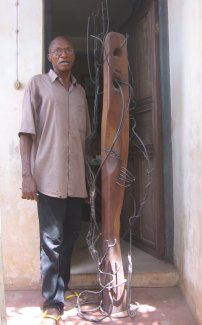If you are interested in getting a better understanding of Contemporary Art in Nigeria, it wouldn’t be a bad idea to read these 35 books. If you know of better ones, please let me know.
B.A. ADEMULEYA, Akin ONIPEDE & Mike OMOIGHE (ed.) Creative traditions in Nigerian art, Culture and Creative Art forum. Lagos 2003
Cornelius O. ADEPEGBA Nigerian Art. Its traditions and modern tendencies. Ibadan, Nigeria, 1995. JODAD Publishers.
Agbarha-Otor 2000: the 3rd Harmattan Workshop Lagos: Ovuomaroro Studio and Gallery, 2000
Agbarha-Otor 2002: the 4th Harmattan Workshop Lagos: Ovuomaroro Studio and Gallery, 2002
John Tokpabere AGBERIA (ed.) Design History in Nigeria. University of Port Harcourt, 2002, National Gallery of Art and Association of Art Designers.
Chike C. ANIAKOR and C. Krydz IKWUEMESI Crossroads. Africa in the twilight. Lagos: The National gallery of Art 2000
Ulli BEIER Thirty years of Oshogbo art. Bayreuth: Iwalewa-Haus, 1991.
Jimoh BURAIMOH My life and Arts. Ibadan 2000, Spectrum Books.
Kevin CARROLL Yoruba religious carving. London 1966, Geoffrey Chapman.
Chinedu C. CHUKUEGGU Contemporary Nigerian Art and its classifications Abraka, Nigeria, 1998. Delsu Consult Publishing House.
G. G. DARAH and Safy QUEL (Ed.) Bruce Onobrakpeya. The spirit in ascent. Ovuomaroro Gallery. Lagos, 1992.
Clémentine DELISS (Ed.) Seven stories about modern art in Africa organized by the Whitechapel Art Gallery; Paris; New York: Flammarion, 1995.
Paul Chike DIKE & Pat OYELOLA The Zaria Art Society: a new consciousness Lagos, 1998. National Gallery of Art, Nigeria
Paul Chike DIKE & Pat OYELOLA Uche Okeke and Modern Nigerian Art Lagos, 2003. National Gallery of Art, Nigeria.
Osa EGONWA African Art: a contemporary source book Benin City, Nigeria, 1994. Osazu Publishers.
Kunle FILANI Patterns of culture in Contemporary Yoruba Art Symphony Books, 2005
Kunle FILANI, A. AZEEZ & A. EMIFONIYE (eds.) Perspectives on Culture and Creativity in Nigerian Art Culture and Creative Art Forum. Lagos, 2003
Kojo FOSU 20th Century Art of Africa Zaria: Gaskiya Corporation, 1986 and Accra: Artist Alliance, 1993.
C. Krydz IKWUEMESI, Ayo ADEWUNMI (Ed.) A discoursive bazaar Enugu: Pan-African Circle of Artists 2001
C. Krydz IKWUEMESI (Ed.) The triumph of a vision: an anthology on Uche Okeke and modern Art in Nigeria Lagos: Pendulum Art Gallery 2003
C. Krydz IKWUEMESI, Emeka AGABAYI (Ed.) The rediscovery of tradtion: Uli and the politics of culture Lagos: Pendulum Centre for Culture and Development 2005
Sidney L. KASFIR. Contemporary African Art. London: Thames and Hudson, 1999.
Bernice M. KELLY & Janet L. STANLEY Nigerian Artists. A who’s who and Bibliography. London, New York: Published for the National Museum of African Art Branch, Smithsonian Institution Libraries, Washington, DC, by Hans Zell, 1993
Nkiru NZEGWU Contemporary Textures: Multidimensionality in Nigerian Art Binghamton. The International Society for the Study of Africa (ISSA). 1999
Olu OGUIBE Uzo Egonu, an African Artist in the West. London: Kala Press, 1995.
Olu OGUIBE and Okwui ENWEZOR, eds. Reading the Contemporary: African Art from Theory to the Marketplace. Cambridge: MIT Press, 1999.
Uche OKEKE Art in development: a Nigerian perspective / edited by Leclair Grier Lambert. Nimo, Anambra State: Documentation Centre, Asele Institute; Minneapolis: African American Cultural Center, 1982.
Bruce ONOBRAKPEYA Sahelian masquerades: artistic experiments, November 1985-August 1988 / edited by Safy Quel. Papa Ajao, Mushin, Lagos: Ovuomaroro Gallery, 1988.
Simon OTTENBERG New Traditions from Nigeria: seven artists of the Nsukka group. Washington: Smithsonian Institution Press, 1997.
Simon OTTENBERG (Ed.) The Nsukka Artists and Nigerian Contemporary Art. Washington DC: Smithsonian Institution Press, 2002.
Pat OYELOLA Everyman’s guide to Nigerian art. Lagos. Cultural Division, Federal Ministry of Information, 1976.
Grace STANISLAUS (Ed.). Contemporary African Artists: Changing Traditions. New York: The Studio Museum in Harlem. 1990.
S. J. TIMOTHY-ASOBELE Contemporary Nigerian arts and Artists: A modern guide. Lagos. Upper Standard Publications. 1992.
Obiora UDECHUKWU Uli: Traditional Wall Painting and Modern Art from Nigeria Bayreuth: Iwalewa House, 1990.
Susan M. VOGEL Africa Explores: 20th Century African Art. New York, Munich, 1986.
AA. VV. The nucleus: a catalogue of works in the national collection on the inception of the National Gallery of Modern Art . Lagos: Federal Department of Culture, 1981.


